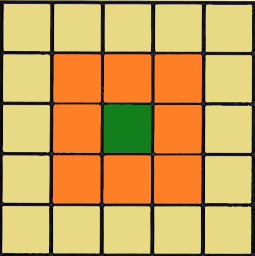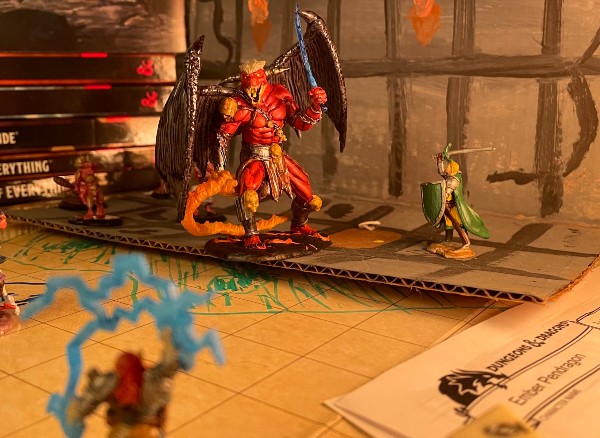The spell’s damage increases by 1d6 when you reach 5th level (2d6), 11th level (3d6), and 17th level (4d6).
Casting Time: 1 action
Range: 5 feet
Components: S
Duration: Instantaneous
School: Evocation cantrip
Xanathar’s Guide to Everything, pg. 168
Thunderclap 5e
Thunderclap — the AoE thunder cantrip that works the way everyone thinks Thunderwave works the first time they read it. Let’s cover the spell’s rules and applications, as well as provide tips for DMs wondering just how loud to make Thunderclap.
We’ll also go over why players usually skip this cantrip in favor of Sword Burst.
Who Can Cast Thunderclap in 5e?
The following classes have Thunderclap on their spell list:
No subclasses get Thunderclap for free.
What Does Thunderclap Do in 5e?
Thunderclap forces all creatures (allies included) within 5 feet of the caster (except the caster themselves) to make a Constitution saving throw. If a creature fails, it takes 1d6 (average 3.5) thunder damage.
The spell is audible up to 100 feet from the caster, but has no effect on creatures within that range.
To be clear about Thunderclap’s range, it originates from the caster. So if you’re using a square grid battle map, the eight squares around the caster will be affected, as illustrated below:

The green square is the caster, and the orange squares are the affected tiles.
Finally, like most damaging cantrips, Thunderclap’s damage automatically increases at 5th, 11th, and 17th levels by 1d6.
What Are the Rules for Thunderclap in 5e?
The rules for Thunderclap in DnD 5e are as follows:
-
Thunderclap does not have a range of Self (5-feet) or 5-foot cube/sphere. These are common misreadings or misinterpretations of the spell’s range. Unlike Thunderwave, which affects a cube emanating from the caster as the point of origin, Thunderclap surrounds the caster.
In fact, it is impossible to cast Thunderwave in such a way that the caster is at the center of its effect, whereas Thunderclap can only be cast this way.
-
Thunderclap affects allies. Because Thunderclap explicitly reads, “Each creature within range, other than you,” that’s who it affects. Since it doesn’t specify anything about hostile or friendly creatures, it damages all creatures — allies included.
-
Thunderclap can benefit from Sorcerer’s Distant Spell metamagic (PHB 102). Because of the above ruling, Thunderclap’s range can be doubled via Sorcerer’s Distant Spell to affect all creatures within 10 feet of the caster.
The Spell Sniper feat (PHB 170), however, does not work with Thunderclap because it does not require an attack roll.
-
Thunderclap can affect creatures above/below the caster. “Within 5 feet of the caster” certainly extends above and below the caster, if there are creatures there to be affected.
-
You can cast Thunderclap in Silence, but it won’t do anything. An odd quirk of Thunderclap is that it requires only a somatic component. This means that it’s one of only ~4% of the game’s spells that can be cast while within the Silence spell.
Ironically, it also deals thunder damage, which Silence makes all creatures in its range immune to.
How Do I Use Thunderclap in 5e?
Here are a few ways to use Thunderclap in DnD:
-
Surround yourself with foes. Thunderclap’s measly 1d6 damage can be multiplied a few times over if you’re able to cast Thunderclap within range of multiple enemies. This is best used against swarms of low-health, low-damage enemies who rely on pack tactics.
Do keep in mind that you’ll be putting yourself in striking distance of several enemies with this tactic, so it pays to be tanky or have a follow-up plan to make it work.
-
Sound an alarm/signal/diversion. While Thunderclap’s 100-foot audible range is usually a negative, it can actually come in handy for some scenarios. Need to warn your party that danger’s on the way? Crack a bit of thunder.
Want to signal your distant mates that it’s time to attack? Ba-boom. Feel the urge to trick a bunch of orcs into a small space to, say, blast them with a follow-up Fireball? Get the party started with some Thunderclap.
-
Be a gish-type character. This is more of a strategic tip, but it’s the most important one here. Thunderclap doesn’t really work on most full casters because most full casters don’t like to be in striking distance of multiple enemies.
Beyond the obvious problem of low hit points, there’s very often concentration on important spells to consider.
But for characters like Eldritch Knight Fighters or Hexblade Warlocks, it’s a decent cantrip option. This is where most players jump in to say, “yea, but Sword Burst is better.” Which we’ll get into later.
Who Can I Target With Thunderclap 5e?
You target the 8 squares around you with Thunderclap, as well as the space above and below you.
Is Thunderclap 5e a Good Spell?
No, Thunderclap is not a good spell for most character builds. It suffers from the problem that most casters don’t exactly enjoy surrounding themselves with enemies, which is the best way to optimize this spell’s damage.
That being said, certain characters that rely on magic as well as combat (most notably, good tanky stats) will get a lot of mileage out of a cantrip like Thunderclap.
But there’s one last problem — many of the builds that like Thunderclap also have the option to take Sword Burst…
Thunderclap 5e Compared to a Sword Burst
Tasha’s Cauldron of Everything introduced a spell that’s very similar to Thunerclap: Sword Burst. Sword Burst is available to all of the same classes as Thunderclap except for Bards and Druids.
Like Thunderclap, Sword Burst affects all creatures within 5 feet of the caster and deals 1d6 (average 3.5) damage. The two differences with Sword Burst are that it deals force damage instead of thunder and requires a Dexterity saving throw instead of a Constitution saving throw.
Force damage is a less common resistance/immunity than thunder (though neither are very common), and Dexterity is a much lower average monster ability score than Constitution. In other words, Sword Burst is better than Thunderclap because it will land more often.
Not to mention that Sword Burst isn’t noisy, making it more usable in scenarios where noise is a factor. Sword Burst has only a verbal component compared to Thuncerclaps somatic component, but that’s unlikely to matter often.
Thunderclap 5e DM Tips
The question DMs have with Thunderclap and similar noisy spells like Knock and Thunderwave is how much they want to make players pay for casting it.
The 100-foot range on Thunderclap is considerably lower than those other two spells, so it might not automatically attract every single monster that you’ve included in your dungeon.
And even if every monster does hear it, you shouldn’t feel compelled to make all of them react by immediately heading toward the source. Some dungeon dwellers might actually flee from such a loud and threatening noise.
That said, if a player forgets that they’re on a stealth mission and lets out a Thunderclap near a sleeping pack of adversaries, they deserve to be taught a lesson about the dangers of noisy spells. One lesson is usually enough to stick!
Simple Thunderclap 5e Spell Text
Thunderclap: (Evocation cantrip, 5 feet, S) Each creature but you within range must succeed on a Constitution saving throw or take 1d6 thunder damage. | +1d6 at 5th, 11th, and 17th levels.
How to Use Other Evocation Spells in DnD 5e
Is Booming Blade good?
Is Eldritch Blast good?
Is Fire Bolt good?
Is Frostbite good?
Is Green-Flame Blade good?
Is Light good?
Is Lightning Lure good?
Is Sacred Flame good?
Is Shocking Grasp good?
Is Word Of Radiance good?
Is Burning Hands good?
Is Chromatic Orb good?
Is Cure Wounds good?
Is Faerie Fire good?
Is Guiding Bolt good?
Is Healing Word good?
Is Hellish Rebuke good?
Is Magic Missile good?
Is Searing Smite good?
Is Thunderous Smite good?
Is Thunderwave good?
Is Witch Bolt good?
Is Darkness good?
Is Scorching Ray good?
Is Shatter good?
Is Spiritual Weapon good?
Is Aura Of Vitality good?
Is Daylight good?
Is Sending good?
Is Leomund’s Tiny Hut good?

![Spike Growth 5e [DnD Spell Guide: Uses, Rules, Tips] entangle-5e-druid](https://www.dndlounge.com/wp-content/uploads/2022/03/entangle-5e-druid-300x174.jpg)
![Shillelagh 5e [DnD Spell Guide: Uses, Rules, Tips] owlbear-dnd-5e](https://www.dndlounge.com/wp-content/uploads/2022/03/owlbear-dnd-5e-300x218.jpg)
![Shape Water 5e [DnD Spell Guide: Uses, Rules, Tips] dnd-5e-character-sheet-and-die](https://www.dndlounge.com/wp-content/uploads/2022/03/dnd-5e-character-sheet-and-die-300x157.jpg)
![Aura of Vitality 5e [DnD Spell Guide: Uses, Rules, Tips] dungeons-and-dragons-party-vs-blue-dragon](https://www.dndlounge.com/wp-content/uploads/2022/03/dungeons-and-dragons-party-vs-blue-dragon-300x223.jpg)